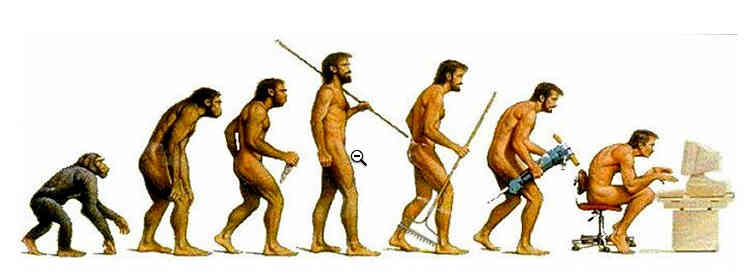It is obvious that the creation account in the Biblical book of Genesis is very different to the current scientific understanding of the origin or the human race.
If you believe in the Bible, must you reject evolution because of this contradiction? And if you accept the science of evolution, must you reject the Bible as a revelation of God?
Or is it possible, perhaps even reasonable, to accept both?
How would this work?
On this page I summarise the evidence for evolution, the arguments of critics, other ideas about origins, other ways to understand the Bible and how theological problems raised by evolution might be solved.
The problem for Christians
Evolution challenges Christianity on three levels:
- It is a challenge to the truthfulness of the Bible, or at least of Genesis. The stronger the doctrine a christian holds about the Bible, the greater will be the challenge.
- It challenges the truth of the christian view of the human race as made in the image of God.
- Evolution negates one of the formerly strong philosophical arguments for the existence of God, the design argument, based on the complexity of human life. (These days, the design argument centres on cosmology.)
Christianity has adapted easily to other challenges from science, such as the end of the flat earth and geocentrism, but evolution has been different.
The science of biological evolution
A summary of the findings of mainstream evolutionary science is provided in a statement by the InterAcademy Panel. It includes such conclusions as the age of the earth (about 4.5 billion years) and of life on earth (more than 2.5 billion years), the evolution of life via mutation and natural selection, and the use of the scientific method to investigate such matters.
Scientists generally believe that the gradual evolution of life over a long period of time is a proven fact, but that some of the mechanisms and processes remain uncertain. A summary of the evidence for evolution is provided by the University of California and BioLogos.
Fossils
Fossils provide an incomplete, but nevertheless convincing, picture of the evolution of life. Combined with radiometric dating and mapping of rock strata, relative ages can be estimated and the evolutionary “tree” described.
Homologies
These are similar anatomical or cellular structures in different animals, suggesting common descent – e.g. many animal forelimbs share the same set of bones – humerus, radius, and ulna.
Testing of concepts
Natural selection and adaptation can be tested by modern day experiments and observations that show the feasibility and reality of this mechanism.
- Experiments with microbial populations allow many generations of evolution to be studied (one experiment has run long enough to allow 68,000 generations). These studies show how populations adapt to different environments and to changes in those environments, and demonstrate natural selection at work.
- Light coloured peppered moths in England adapted to the darkening of tree trunks during the industrial revolution via a mutation which produced a darker colour which became advantageous for camouflage. More recently, as pollution has reduced, lighter coloured trees have begun to favour lighter coloured moths – as natural selection predicts.
- Similar studies have shown how finches beaks, human lactose intolerance, pesticide resistance in insects and antibiotic resistance in bacteria all illustrate natural selection.
DNA
DNA molecules are strings of complex chemicals in several billion “base pairs”. Each of us inherit portions of DNA from parents, grandparents, etc. If two people share the same segment of DNA composed of millions of base pairs, there is almost zero chance this happens by chance – and almost certain it is a result of common ancestry. This science provides family historians with a method to identify relatives that has been proven over and over again.
The same science can be used to trace more distant human ancestry. DNA can identify common ancestors, the developments of different species, migration paths and genetic similarities between species, all indicators of common descent. It also allows approximate dating.
I think DNA may be the most convincing evidence for evolution. If evolution isn’t true, God has certainly made it look as if common descent and evolution over a long time scale are true!
Arguments against evolution
A number of perceived weaknesses in the scientific evidence for evolution have been picked up by critical christians. Here I give the arguments and the counter arguments.
“Gaps” in the fossil record
Evolution is essentially a slow and gradual process of accumulation of small changes, and the fossils discovered so far only record a small percentage of the plant and animal species which have existed. One might expect the fossil record to include fossils randomly from the entire process of evolution, however, while most major groups and species are represented among the fossils, relatively few “transitional” fossils (between the major groups and species) have been found to fill the gaps. Critics of evolution argue that this invalidates evolution as a process that produces the complexity of life we see around us.
But evolutionists explain this situation as follows:
- One would not expect large numbers of fossils to be found because the particular conditions required for fossils to form do not occur everywhere, and, of these, only a relatively small percentage are likely to be unearthed.
- Because of variations in the types of plants and animals, and the geographic conditions in which they lived, one would not expect an even distribution of fossils across all species.
- Some evolutionists, notably the late Stephen Jay Gould, believed the fossil record indicated a “punctuated equilibrium” in which periods of little change were followed by periods of great change, rather than a slow linear process.
- Transitional species may not have been in existence for long periods of time, and hence would naturally be less likely to appear in the fossil record.
- Many transitional fossils have been found, including some whose non-existence had once been considered as most damaging to evolution.
It seems this objection is reasonably answered, although continued lack of success in finding some transitional fossils may eventually throw doubt on some current understandings of processes.
The Cambrian explosion
The fossil record for the Cambrian Period, more than 500 million years ago, shows the relatively sudden appearance (over a period of perhaps 5-30 million years), without previous ancestors or transitional forms, of most of the phyla known today. (Phyla are major groupings of plants and animals based on their body plan. There are about 35 phyla today, and most appeared, or are believed to have originated, in the Cambrian Period). At first sight, this appears contradictory to Darwinianism, and very difficult to explain.
The Darwinist responses include:
- Contradiction – it simply didn’t occur, it isn’t possible, and the evolution of new phyla actually took longer than the current fossil record may suggest.
- There were earlier ancestors, but their fossils have not been preserved because they were not organisms that commonly left fossils.
- There was a long period before the Cambrian where genes developed to a certain stage, which then allowed the new phyla to develop relatively quickly.
- There were, perhaps, special conditions (for example increased oxygen levels) which led to this rapid growth.
This still looks to be a small difficulty for evolutionary theory – the several different explanations indicate that a satisfactory understanding has not yet been reached. Nevertheless, it seems wise to give science the benefit of the doubt here.
Transition processes
The evolution of life requires numerous small changes to cumulatively lead to new and more “advanced” species. And for natural selection to operate as a mechanism for this change, every step in the process must confer a survival advantage so that the organism survives to allow the next step in the process. Much debate centres around whether plausible processes can be found that explain the evolution of complex biological body parts, such as the eye.
Of course it isn’t possible to demonstrate the evolution of new species with new biological functions in a laboratory, so ‘demonstration’ generally involves understanding how the new organism is related to its ancestor organism, determining what changes in anatomical structure are required, showing from the fossil record or some form of modelling, that such changes could have occurred, and demonstrating how each of the major steps had survival value (perhaps by showing homologies – examples of similar structures which “work” in present day organisms).
Using such processes, evolutionary scientists have explained many difficult to imagine transitions. Many others remain to be explained, but it is claimed that this is only a matter of time.
Irreducible complexity
More than a decade ago, biochemist Michael Behe introduced the idea that the structure of some living cells is “irreducibly complex”, meaning that their functioning is so dependent on all of their components that they could not evolve from a simpler structure.
This is a more significant challenge to evolution, but it is generally accepted that he has not yet demonstrated his case. For example, evolutionists claim to have shown workable transitions to systems, such as the bacteria flagellum and the cilium (two biological “machines” used for propulsion) which Behe claimed were irreducibly complex. It remains to be seen whether the concept of irreducible complexity can be shown to be true in any situation.
This one is tricky to assess. Scientists often claim that transitional processes have been demonstrated or proven, when in fact they have generally only been shown to be feasible – they cannot be established by the normal scientific method of repeatable observation. A more modest claim would seem in order.
The origin of life
The evolution of life is one thing, but evolution requires the existence of a primitive organism to begin the process. (Strictly speaking, the theory of evolution does not address the origin of life.) How did life originate?
It is not easy to define the characteristics of life, but the following abilities are generally part of the definitions:
- to process energy to perform other functions;
- to respond to stimuli and adapt to its surroundings;
- to grow and regenerate worn components; and
- to store information that allows replication.
For the earliest forms of life to be able to perform these functions is no mean feat.
Hydrogen, oxygen, carbon and nitrogen have to be formed into amino acids. Scores of amino acids must then be linked together in an appropriate sequence to form protein molecules and the nucleic acids which make up genetic code. Then a hundred or more protein molecules must combine to form a living cell. That such complex processes could occur naturally is almost beyond belief, and critics of evolution can outline many barriers that must be overcome, and for which current explanations do not appear to be satisfactory.
Science has not as yet been able to demonstrate how it all might have occurred. Many proposals have been examined and none has been found likely at this stage. The methods being used for this research cannot yield the near-certainty that science usually seeks, and some critics will undoubtedly continue to argue that natural forces alone cannot explain the origin of life. Francis Crick, one of the discoverers of the structure of DNA, wrote in 1981: “The origin of life appears to be almost a miracle, so many are the conditions which would have had to be satisfied to get it going.”
Scientists believe thay have made progress on this research and are confident that they will one day be able to demonstrate the process by which life arose. In 2004, biologist W Ford Doolittle wrote: “Origins-of-life science is still very much a work in progress. The sensible bet is that chemists will close this particular gap …. within the next decade.
“ Yet a decade later, Paul Davies could say: “The origin of life is one of the great outstanding mysteries of science.”
So abiogenesis, the beginning of biological life out of chemical components, remains more uncertain than other transitions discussed above. Those committed to a belief that only natural processes can be involved will continue to strive for a feasible process, whereas others may well continue to question the evidence.
Evolutionary science and proof
Most science depends on observation of the world or of controlled experiments in a systematic manner which leads, in the end, to a high level of statistical confidence in the results. However evolutionary science has more limited opportunities to observe or experiment, and must often proceed by less direct and therefore less certain methods.
Scientists sometimes speak as if many of the details of evolution are more certain than they can actually be. No matter how unsatisfactory explanations about any part of the process are, especially about the beginning of life, evolutionary scientists will nevertheless assume that a naturalistic explanation will be found. It seems to me that doubts and questions tend to be shouted down or ridiculed rather than impatially addressed.
Nevertheless, there is no evidence that defeats evolution. It is reasonable to conclude that the problems may be solved in time. But I can’t help feeling that scientists as a whole are so committed to evolution that it would be difficult for them to change their minds if the remaining issues aren’t resolved.
Alternative origin theories
Christians have proposed three different origin hypotheses as an alternative to the scientifically accepted evolution.
Young Earth Creationism
YEC is based on the assumption that the Bible, including the early chapters of Genesis, provides literal scientific information that is more reliable than the findings of science. The earth was created only a relatively short time ago, there really was a snake and a tree of good and evil.
But to most scholars (and to me), Genesis 1-11 reads more like myth or folk tale than history and science, and as early as the fourth century Augustine warned his fellow believers against interpreting Genesis literally and thus appearing foolish to those who knew better.
The evidence for evolution appears to be too strong, and it would not be the first time that christians have changed their interpretation of the Bible because of the discoveries of science – e.g. geocentrism.
Intelligent design?
Intelligent Design (ID) is the view that “certain features of the universe and of living things are best explained by an intelligent cause, not an undirected process such as natural selection.” This view is inferred from “the informational properties of natural objects”, leading to the conclusion that the “form of information which we observe is produced by intelligent action, and thus reliably indicates design”. Thus intelligent design is compatible with evolution and an old age of the earth, it simply argues that natural selection cannot explain all the design in nature
I do not regard ‘Intelligent Design’ as necessarily the same as ‘Creationism’, as some people do. The key for me lies in whether the factual findings of science are accepted or not. Creationists, and some proponents of Intelligent Design, do not accept the findings of mainstream science on matters of fact. However most of those advocating Intelligent Design do accept the factual findings of mainstream science (e.g. the big bang, the ages of the universe and of earth, the evolution of species by natural selection, etc), but they believe these facts are best explained by an intelligent cause rather than natural processes.
It seems to me that the Intelligent Design movement has not yet demonstrated its propositions in a scientific manner, although this does not necessarily mean they are untrue. But even if Intelligent Design is a true insight into God’s actions, science cannot observe or experiment with those actions, so Intelligent Design’s “proofs” struggle to find ways to disprove the possibility of evolutionary processes.
It is therefore difficult to see how Intelligent Design can ever be verified scientifically, and hence it is unlikely to ever be recognised as science. It is possible that science will eventually explain how many of the currently unexplained processes occurred, leaving Intelligent Design with a dwindling impact. But even if explanations are not found, naturalistic scientists will be required by their beliefs to keep believing and searching for explanations. It is hard to see a big future for the Intelligent Design movement, unless it can develop more rigorous and convincing methods.
Theistic evolution (or evolutionary creation)
This view (promoted, for example by BioLogos) accepts the science of evolution as describing the way God chose to create the universe and life, and seeks to use science to better understand God’s creation and to guide theological thinking.
We can see God’s intricate design of the universe in the physical laws and the values of many constants within those laws which appear to be fine-tuned to lead to human life (see Was the universe designed for us). Evolutionary creation believes God so cleverly set up these initial laws that they didn’t need further tinkering to bring forth human life.
It seems to me that this is the only view of origins we can reasonably adopt.

Other ways to understand the Bible
For several centuries at least, and maybe much longer, most Christians have regarded the Bible as speaking truth in all things – not just its teachings about God and ethics, but also its history and “science”. If God wrote it, it must be right, right?
But archaeology, history and science have thrown considerable doubt about those assumptions. At the very least, we have good reason to consider other views, especially of the Genesis creation account.
Genesis 1-11: aetiological myth?
There are good reasons to believe the early chapters of Genesis are not literal history. The creation and flood stories have sufficient similarities to older Akkadian stories (Enuma Elish, and the Atrahasis and Gilgamesh epics) that it seems likely that they share a common source.
All these stories read like aetiological myths – stories developed through repeated telling that explain how a people see themselves and their origins. The repeated re-telling makes it impossible to know what, if any, was the historical basis of the stories. We can be reasonably confident that the stories have been passed down for many generations because (i) a nomadic people almost certainly wouldn’t carry with them the materials to write them down, and (ii) they are written in Hebrew, a language that probably didn’t exist before about 1000 BCE, more than a millennium after the events were said to have taken place.
If this is so, it is probable that Adam & Eve, Cain & Abel and Noah were not historical characters. Christian scholar Denis Lamoureux has made a particular study of how this shouldn’t surprise us or worry us.
Instead, we should see the Genesis creation story as using the pre-scientific understandings of the ancient Middle East to explain a different view of creation from that prevalent at the time. Most ancient Middle Eastern cultures thought many gods, often contending against each other or other forces, created the human race as their servants, and the process and the outcome were chaotic.
In contrast, Genesis identifies one supreme creator God creating a good, orderly world for humans, to whom he gives dignity. The sun and moon weren’t to be worshiped or the turbulent seas feared, as in pagan mythology, but were good created things.
The writers weren’t interested in the mechanisms of how God or the gods created, which is what science is interested in.
This view of Genesis fits a more Middle Eastern, less literal, understanding of the Old Testament which resolves many other problems, and I see no reason to not accept it.
Issues for Christian theology
But acceptance of evolution and this view of Genesis does present a few issues for Christian theology.
Unguided?
Evolutionary science is based on evolution being unguided by any external force or being – its mechanisms are random mutation (or near random) and natural selection. This of course leaves no room for God.
But this is confusing methodological naturalism with philosophical naturalism. Science addresses physical questions and puts aside questions of God and the supernatural (methodological naturalism). But that leaves the reality of the supernatural as an open question (philosophical naturalism). Non-theistic scientists may believe there is no God to interfere, but evolutionary science can’t show this.
Unintelligent design?
There are many strange and sometimes unpleasant things about life on earth, which do not suggest life was designed by God. Examples include the existence of vestigal organs, and the human eye, which some say is badly designed because its blood vessels run across the surface of the retina.
But some unusual features are bound to occur in a process like evolution. If we believe they point to a lack of a designer, we should equally see beautiful pieces of design as evidence of God. I think the arguments cancel each other out.
Adam and Eve
It is hard to fit in the Genesis story of Adam and Eve in any literal way. Some christians attempt to do so, but it is difficult to find a suitable time in human history to place them. But the real clincher is that DNA studies, which have been shown to be accurate in predicting human relationships, show that the genetics of the entire human race could not have come from just two ancestors (unless God created heaps of new DNA along the way!). I accept that the Adam and Eve story is myth of a special kind, not least because (to me at least) it reads more like a myth than history.
The Fall
A lot of christian thinking, and apologetics, is built around the idea that God created a perfect world, but human sin has corrupted human nature and affected the whole earth. Evolution challenges much of that.
In conventional christian theology, “the Fall” is the beginning of sin, pain and suffering in the world. But if human beings evolved via natural selection, competition and pain existed before there were people. So selfishness, which is at least one form of “sin”, existed before there were humans, and it is hard to see how a “fall” is a meaningful concept. Human sin can be explained in evolutionary terms.
We have always known the suffering in the world was caused partly by human sin, and partly by the world itself (e.g. earthquakes, floods, etc), so now we must include animal pain among those less pleasant features of the world that God created. Explaining them is another question.
Original sin
Original sin is a doctrine with several different forms. All say that the human race has inherited a sinful nature from Adam & Eve, and Calvinism says that we also inherit guilt and punishment.
It is difficult to find any place for any doctrine of ‘Original Sin’ if there was no literal Adam and Eve as progenitors. The human race is genetically descended from many people, not a lone couple.
And I think the Calvinistic doctrine lacks strong Biblical support, as well as lacking logic and morality, so I am happy to let that version of the doctrine go. But I see no problem with believing a form of the doctrine that says we each inherit natures that are competitive, selfish and prone to sin.
New Testament references
Jesus and other New Testament characters sometimes refer to parts of Genesis 1-11, suggesting that the events may have really occurred. But the writers wrote from within the culture of their day and used the language, culture, thought forms and understanding of the natural world of their time. Perhaps they believed the stories were true (just as I suppose they may have believed the earth was flat). Perhaps they had never thought about whether the stories were true or not, and didn’t really care.
People sometimes quote myths (especially important myths like these) and fiction stories as if they were real, whether they think they are true or not, and the New Testament quotes non-Biblical mythical stories on a couple of occasions.
Further, Jesus and the apostles often corrected, changed, misquoted or re-applied Old Testament passages, showing they didn’t take a literalist view of their scriptures as many of us do today.
It therefore seems quite reasonable to suppose that these New Testament references don’t establish the literalness of the Adam and Eve story.
A new understanding of the Bible
All this must, if accepted, change how we view the Bible. I think this is one of the positives to come out of the debate about evolution.
Evangelical christians have tended to regard the Bible as an inerrant guidebook of faith and behaviour – at least, that is what they say, although in practice most christians emphasise some teachings and gloss over or explain away others. However there are three good reasons to move away from this view:
1. It doesn’t seem right
When I read the Bible, I see all sorts of things that don’t suggest it is inerrant – apparent inconsistencies in doctrine and history, and teachings and behaviours that don’t seem godly and consistent with Jesus.
2. What the scholars say
Scholars tell us that the Old Testament doesn’t present one clear and unambiguous set of teachings, but is more like a dialogue between several different viewpoints. The compilers of both Testaments chose to preserve the differences.
3. Impugning God’s good character
If God commanded the killing of everyone in the Canaanite cities apparently conquered by Joshua, if he ordered Abraham to kill his son (only to stop him at the last moment), if his laws required many different transgressors to be stoned to death, God’s character is questionable at best.
Surely it is better to see God’s good character (shown in most other parts of the Bible) as the basic truth, and adjust our understanding of the Bible accordingly? We don’t have to try to defend the indefensible of genocide.
An inescapable conclusion?
Therefore it seems to me that we should still see the scriptures as inspired by God for our edification. They give us historical information about Jesus, and about God’s dealings with his people, written by his people using the understandings and thought forms of their day. They show a progression in their understandings of God.
But the scriptures include legend as well as history, and are less like an infallible rule book and more like a gold mine of ideas and experiences which the Holy Spirit uses to bring us closer to God. Paul says we now walk in the new way of the Spirit, no longer by the written code (Romans 7:6, 2 Corinthians 3:6). For more on this, see How to interpret the Bible?.
Far from threatening our faith in God and the Bible, evolution clarifies and strengthens it.
References
Discoveries about the nature of life
- Charles Darwin’s “The Origin of Species” (Wikipedia)
- The Human Genome project to “map” human genes and DNA.
The evolution of life
- Evolution – Wikipedia
- Understanding Evolution. University of California.
- Theory of Evolution. National Georgraphic.
- Timeline: The evolution of life. NewScientist.
- American Scientific Affiliate – website of an organisation of christian scientists.
- DNA, genes and human history. Is there a God? (my other blog)
- Experimental Studies of Natural Selection. LibreTexts.
The fossil record
- Fossil and List of transitional fossils. Wikipedia.
- Taxonomy, Transitional Forms, and the Fossil Record. Keith B. Miller, Kansas State University.
- Creationist claims. Mark Isaac, The TalkOrigins Archive.
- Darwinists and the Fossil Record. Intelligent Design.
- Transitional vertebrate fossils. Kathleen Hunt
The Cambrian explosion
- Cambrian explosion. Wikipedia.
- The Precambrian to Cambrian Fossil Record and Transitional Forms. Keith B. Miller, Kansas State University.
- The Cambrian “Explosion”, Transitional Forms, and the Tree of Life. BioLogos.
- The Scientific Controversy Over the Cambrian Explosion. Discovery Institute.
Transition processes
- Answering the Biochemical Argument from Design. Kenneth R. Miller, Brown University.
- The Flagellum Unspun: the Collapse of “Irreducible Complexity”. Kenneth R. Miller, Brown University.
- Irreducible complexity and Michael Behe: on Idea, and Talk Origins.
- Evolution of the eye. Dan-Erik Nilsson.
- Did eyes evolve by Darwinian mechanisms?. Jerry Bergman on creation.com.
The origin of life
- Life. Wikipedia.
- The Origin and Early Evolution of Life W Ford Doolittle, Biochemistry Professor, Dalhousie University, Canada. In “Evolutionary Science and Society: Educating a New Generation” (page 35) Edited by Joel Cracraft and Rodger Bybee.
- Origin and definition of life. Michael Pidwirny, University of British Columbia.
- Studying the origin of life and How did life originate?. University of California, Berkeley.
- The Origin of Life. Albrecht Moritz.
- Top Five Problems with Current Origin-of-Life Theories Evolution News.
Understanding the OId Testament
- Wisdom for Faithful Reading. John H Walton, IVP.
- How the Bible Actually Works. Peter Enns, Harper Academic.
Main graphic: Wikipedia. Second graphic: : The PIX-JOCKEY (photo manipulation) via Compfight cc




